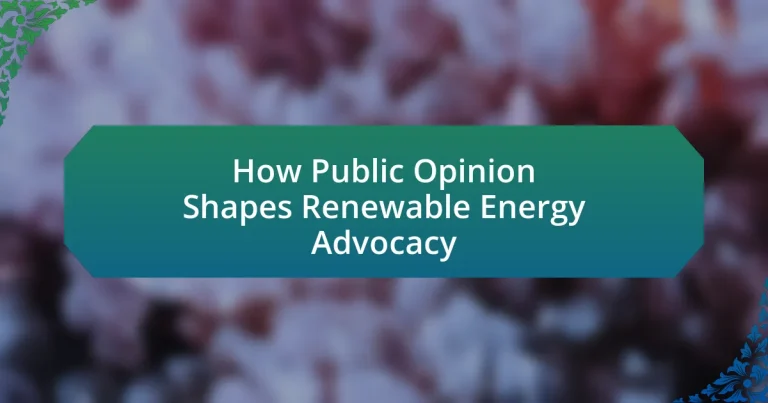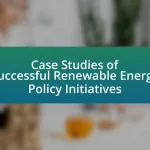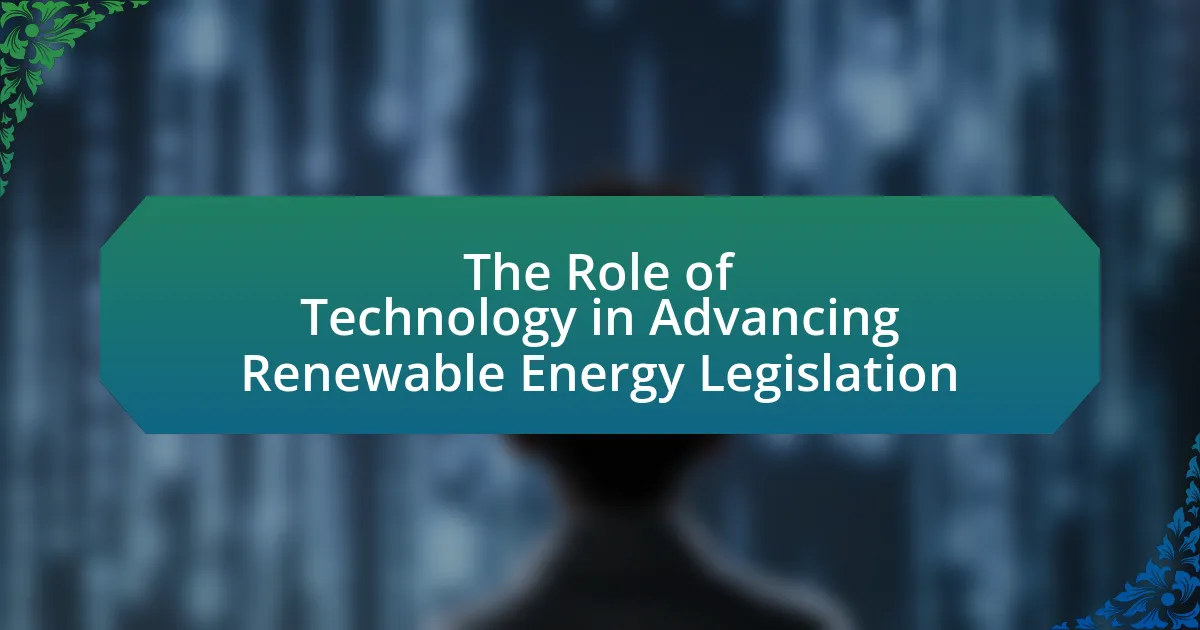Public opinion plays a critical role in shaping renewable energy advocacy by influencing policy decisions and funding allocations. The article explores how public support for renewable energy initiatives, such as solar and wind power, drives legislative action and investment, as evidenced by surveys indicating high levels of public favor. It examines the factors that shape public opinion, including awareness of climate change, economic considerations, political ideology, and media influence. Additionally, the article discusses the impact of social movements and advocacy groups in mobilizing support, as well as the importance of effective communication and community engagement in fostering positive public perceptions of renewable energy.
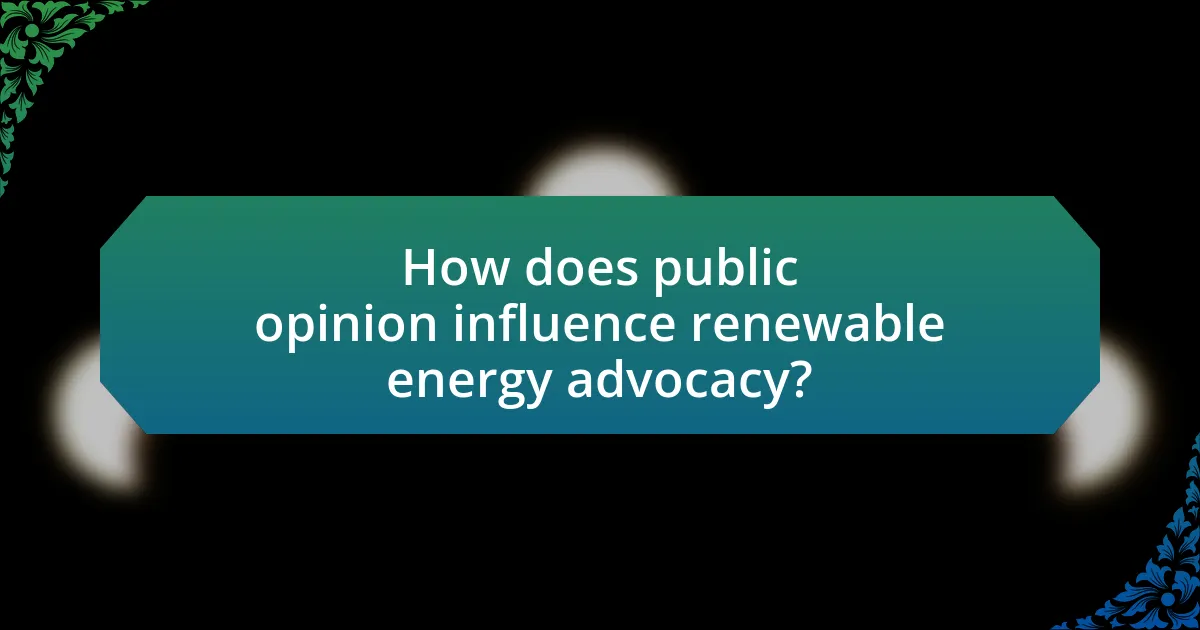
How does public opinion influence renewable energy advocacy?
Public opinion significantly influences renewable energy advocacy by shaping policy decisions and funding allocations. When a majority of the public supports renewable energy initiatives, policymakers are more likely to prioritize these issues, leading to increased investment and legislative support. For instance, a 2021 Gallup poll indicated that 79% of Americans favor the development of solar power, which has prompted various state governments to implement supportive policies and incentives for solar energy projects. This correlation between public sentiment and political action demonstrates how advocacy efforts can gain momentum when they align with the views of the electorate.
What factors shape public opinion on renewable energy?
Public opinion on renewable energy is shaped by factors such as awareness of climate change, economic considerations, political ideology, and media influence. Awareness of climate change drives individuals to support renewable energy as a solution to environmental issues, with studies indicating that 70% of people are more likely to favor renewable sources when they understand the impacts of climate change. Economic considerations, including job creation in the renewable sector and the decreasing costs of technologies like solar and wind, also play a significant role; for instance, the International Renewable Energy Agency reported that renewable energy jobs reached 11.5 million globally in 2018. Political ideology influences opinions, as individuals with progressive views tend to support renewable energy more than conservative counterparts. Lastly, media coverage can significantly sway public perception, with positive portrayals of renewable energy leading to increased public support, as evidenced by surveys showing that media narratives can shift opinions by up to 20%.
How do media representations affect public perceptions of renewable energy?
Media representations significantly shape public perceptions of renewable energy by influencing awareness, attitudes, and understanding of the subject. For instance, positive portrayals in news articles and documentaries can enhance public support for renewable energy initiatives, as evidenced by a study published in the journal “Energy Policy,” which found that favorable media coverage correlates with increased public acceptance and willingness to adopt renewable technologies. Conversely, negative representations, such as highlighting the challenges or failures of renewable projects, can lead to skepticism and resistance among the public. This dynamic illustrates how the framing of renewable energy in media can directly impact societal attitudes and policy advocacy.
What role do social movements play in shaping public opinion?
Social movements play a crucial role in shaping public opinion by mobilizing individuals around specific issues, raising awareness, and influencing societal norms. For instance, the environmental movement has significantly impacted public attitudes toward renewable energy, leading to increased support for sustainable practices and policies. Research indicates that social movements can shift public perception through campaigns, protests, and advocacy, effectively changing the discourse surrounding energy sources. A study by the Pew Research Center found that public concern about climate change has risen in tandem with the activities of environmental movements, demonstrating a direct correlation between activism and shifts in public opinion.
Why is public opinion important for renewable energy policies?
Public opinion is crucial for renewable energy policies because it influences political decision-making and resource allocation. When the public supports renewable energy initiatives, policymakers are more likely to prioritize and implement these policies, as seen in various countries where public advocacy has led to increased funding and legislative support for renewable projects. For instance, a 2021 survey by the Pew Research Center found that 79% of Americans favor expanding solar panel farms, demonstrating that strong public backing can drive significant policy changes in favor of renewable energy.
How does public support impact government decisions on renewable energy?
Public support significantly influences government decisions on renewable energy by shaping policy priorities and funding allocations. When a substantial portion of the population advocates for renewable energy, governments are more likely to respond with supportive legislation and financial incentives. For instance, a 2021 survey by the Pew Research Center found that 79% of Americans support the expansion of solar and wind energy, prompting various state governments to implement policies that promote these energy sources. This correlation between public opinion and governmental action demonstrates that when citizens express strong preferences for renewable energy, it can lead to increased investment and regulatory frameworks that facilitate the transition to sustainable energy solutions.
What are the consequences of public opposition to renewable energy initiatives?
Public opposition to renewable energy initiatives can lead to significant delays in project implementation and increased costs. When communities resist renewable energy projects, developers often face lengthy permitting processes, legal challenges, and the need for additional outreach efforts to address concerns. For instance, a study by the National Renewable Energy Laboratory found that public opposition can extend project timelines by an average of 1 to 3 years, resulting in increased financial burdens due to prolonged development phases. Additionally, such opposition can deter investment in renewable energy, as investors may perceive projects as high-risk when faced with community resistance, ultimately hindering the transition to sustainable energy sources.
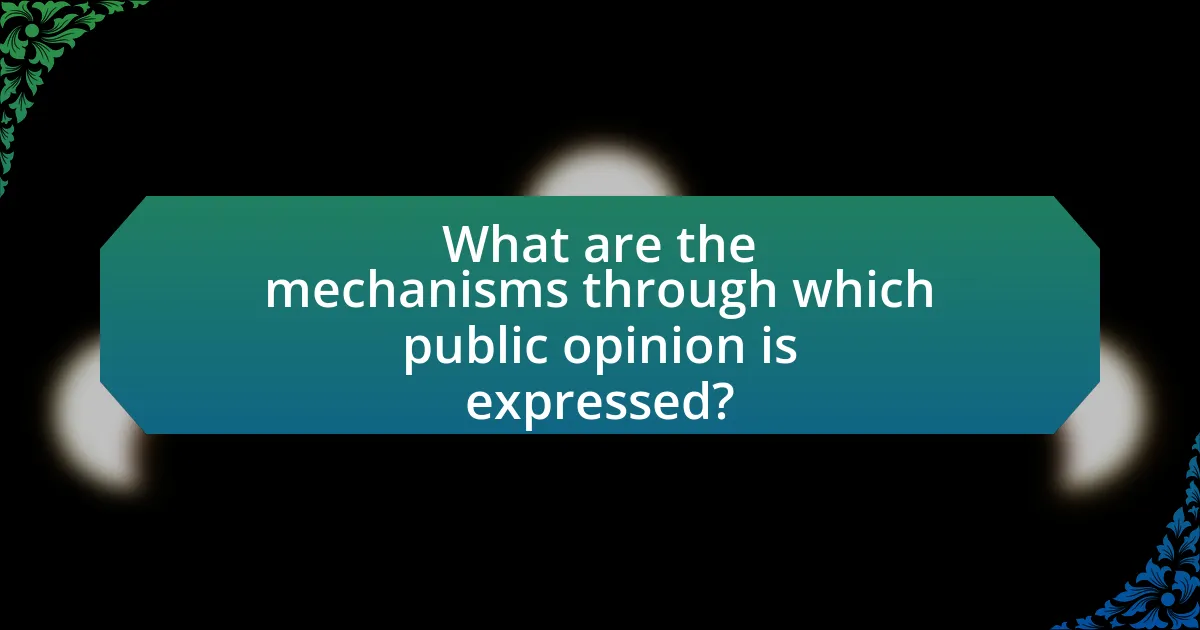
What are the mechanisms through which public opinion is expressed?
Public opinion is expressed through various mechanisms, including surveys, social media, public demonstrations, and traditional media outlets. Surveys, such as polls conducted by organizations like Gallup, quantify public sentiment on issues, providing measurable data on opinions. Social media platforms enable individuals to share their views widely and engage in discussions, influencing and reflecting collective attitudes. Public demonstrations, such as protests or rallies, serve as a physical manifestation of public sentiment, drawing attention to specific issues. Traditional media outlets, including newspapers and television, disseminate information and opinions, shaping public discourse and awareness. Each of these mechanisms plays a crucial role in articulating and influencing public opinion on topics, including renewable energy advocacy.
How do surveys and polls reflect public sentiment on renewable energy?
Surveys and polls reflect public sentiment on renewable energy by quantifying opinions and attitudes towards energy sources and policies. For instance, a 2021 Gallup poll indicated that 79% of Americans support the development of solar energy, demonstrating strong public backing for renewable initiatives. These data points help policymakers and advocates understand the level of public support or opposition, guiding decisions on energy legislation and investment. Additionally, trends in survey results over time can reveal shifts in public perception, influenced by factors such as climate change awareness and technological advancements in renewable energy.
What methodologies are used to gauge public opinion on energy issues?
Surveys and polls are the primary methodologies used to gauge public opinion on energy issues. These tools collect quantitative data from a representative sample of the population, allowing researchers to analyze attitudes, beliefs, and preferences regarding energy sources and policies. For instance, the Pew Research Center frequently conducts surveys that reveal public sentiment on renewable energy, showing that a significant majority of Americans support solar and wind energy initiatives. Additionally, focus groups and interviews provide qualitative insights, capturing the nuances of public opinion and facilitating a deeper understanding of the motivations behind individuals’ views on energy matters.
How reliable are public opinion polls in influencing policy?
Public opinion polls are generally reliable in influencing policy, as they provide measurable insights into the preferences and attitudes of the electorate. Research indicates that policymakers often use these polls to gauge public sentiment, which can directly impact legislative decisions. For instance, a study by the Pew Research Center found that 70% of lawmakers consider public opinion data when shaping their policies, particularly in areas like renewable energy, where public support can drive legislative action. This demonstrates that public opinion polls serve as a critical tool for understanding and responding to constituents’ needs, thereby influencing policy outcomes effectively.
What role do advocacy groups play in shaping public opinion?
Advocacy groups play a crucial role in shaping public opinion by mobilizing support for specific issues, influencing policy decisions, and raising awareness through targeted campaigns. These organizations utilize various strategies, including grassroots mobilization, media engagement, and research dissemination, to communicate their messages effectively. For instance, a study by the Pew Research Center found that advocacy groups significantly impact public perceptions of climate change and renewable energy, with 70% of Americans indicating that they trust information from environmental organizations. This trust enhances the credibility of their messages, leading to increased public support for renewable energy initiatives.
How do grassroots campaigns mobilize public support for renewable energy?
Grassroots campaigns mobilize public support for renewable energy by engaging local communities through education, advocacy, and direct action. These campaigns often utilize social media platforms to disseminate information about the benefits of renewable energy, such as reduced carbon emissions and job creation in green industries. For instance, a study by the American Council on Renewable Energy found that grassroots efforts can significantly increase public awareness and support, with 70% of participants in community meetings expressing a favorable view of renewable projects after being informed about their local benefits. Additionally, grassroots organizations often collaborate with local leaders and stakeholders to create a sense of ownership and urgency around renewable energy initiatives, further galvanizing community involvement and support.
What strategies do advocacy organizations use to influence public perception?
Advocacy organizations use various strategies to influence public perception, including targeted messaging, social media campaigns, and coalition building. Targeted messaging involves crafting specific narratives that resonate with the values and concerns of the audience, which can significantly shape opinions on renewable energy issues. For example, organizations like the Sierra Club have effectively used storytelling to highlight personal experiences related to climate change, making the issue more relatable and urgent.
Social media campaigns leverage platforms to disseminate information quickly and engage with the public directly, allowing organizations to counter misinformation and mobilize support. A study by the Pew Research Center found that social media is a critical tool for advocacy, with 69% of adults using these platforms to stay informed about current events, including environmental issues.
Coalition building brings together diverse stakeholders, such as businesses, community groups, and environmentalists, to present a united front. This strategy enhances credibility and amplifies the message, as seen in initiatives like the Renewable Energy Buyers Alliance, which unites major corporations to advocate for clean energy policies. These strategies collectively enhance the effectiveness of advocacy organizations in shaping public perception regarding renewable energy.
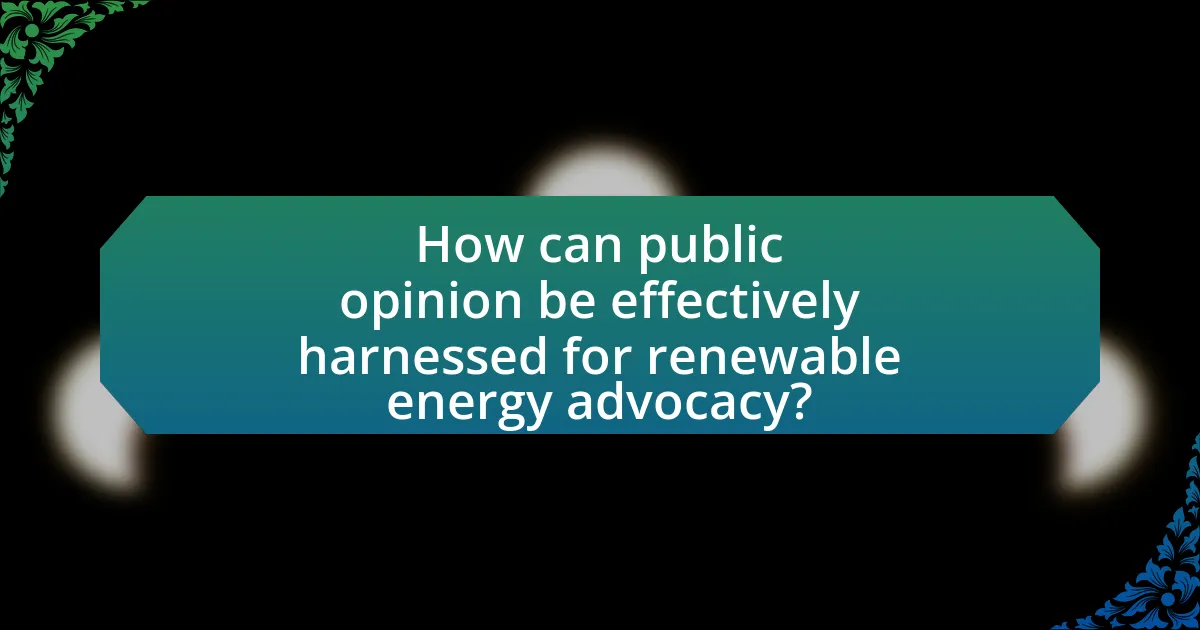
How can public opinion be effectively harnessed for renewable energy advocacy?
Public opinion can be effectively harnessed for renewable energy advocacy by utilizing targeted communication strategies that engage and inform the public about the benefits of renewable energy. Research indicates that framing renewable energy in terms of economic benefits, job creation, and environmental sustainability resonates strongly with the public, leading to increased support. For instance, a study by the Yale Program on Climate Change Communication found that 70% of Americans support expanding solar energy, particularly when presented with data on job growth in the sector. Additionally, leveraging social media platforms to amplify grassroots movements and personal stories can create a sense of community and urgency around renewable energy initiatives, further solidifying public support.
What strategies can be employed to improve public understanding of renewable energy?
To improve public understanding of renewable energy, educational campaigns that utilize clear, accessible information and community engagement strategies should be employed. These campaigns can include workshops, informational websites, and social media outreach that explain the benefits and workings of renewable energy sources, such as solar and wind power. Research indicates that when individuals receive information through relatable formats, such as local success stories or interactive demonstrations, their understanding and acceptance of renewable energy significantly increase. For instance, a study by the National Renewable Energy Laboratory found that community-based programs that involve hands-on learning experiences can enhance knowledge retention and foster positive attitudes toward renewable energy initiatives.
How can educational initiatives enhance public support for renewable energy?
Educational initiatives can enhance public support for renewable energy by increasing awareness and understanding of its benefits and importance. When educational programs provide clear information about renewable energy technologies, their environmental advantages, and economic potential, they empower individuals to make informed decisions. For instance, studies show that communities with robust educational outreach programs exhibit higher acceptance rates for renewable energy projects, as evidenced by a 2019 survey from the National Renewable Energy Laboratory, which found that informed citizens are 60% more likely to support local renewable energy initiatives. This correlation highlights the critical role of education in shaping positive public perceptions and fostering advocacy for renewable energy solutions.
What role does community engagement play in fostering positive public opinion?
Community engagement plays a crucial role in fostering positive public opinion by creating a sense of ownership and trust among stakeholders. When communities are actively involved in discussions and decision-making processes regarding renewable energy projects, they are more likely to support these initiatives. Research indicates that projects with high levels of community participation experience greater acceptance and lower opposition rates. For instance, a study by the University of California found that community engagement efforts, such as public meetings and feedback sessions, significantly increased local support for wind energy projects by up to 30%. This demonstrates that effective community engagement not only informs the public but also aligns project goals with community values, ultimately enhancing public perception and advocacy for renewable energy.
What best practices can advocates follow to align public opinion with renewable energy goals?
Advocates can align public opinion with renewable energy goals by employing effective communication strategies, engaging community stakeholders, and utilizing data-driven campaigns. Effective communication involves simplifying complex renewable energy concepts into relatable messages that resonate with the public, thereby increasing understanding and support. Engaging community stakeholders, such as local leaders and organizations, fosters trust and encourages grassroots involvement, which is crucial for building a supportive network. Data-driven campaigns that highlight the economic, environmental, and health benefits of renewable energy can further persuade the public; for instance, studies show that communities investing in renewable energy often experience job growth and reduced energy costs. These practices collectively enhance public perception and acceptance of renewable energy initiatives.
How can advocates effectively communicate the benefits of renewable energy?
Advocates can effectively communicate the benefits of renewable energy by utilizing clear messaging that emphasizes economic, environmental, and social advantages. For instance, highlighting that renewable energy sources, such as solar and wind, can reduce greenhouse gas emissions by up to 80% compared to fossil fuels provides a compelling environmental argument. Additionally, presenting data from the International Renewable Energy Agency, which indicates that renewable energy jobs have grown to over 11 million globally, underscores the economic benefits and job creation potential. By using relatable examples and statistics, advocates can engage the public and policymakers, fostering a better understanding of renewable energy’s positive impact on society and the economy.
What are common pitfalls to avoid in renewable energy advocacy efforts?
Common pitfalls to avoid in renewable energy advocacy efforts include failing to engage with local communities, neglecting to address economic concerns, and relying on overly technical language. Engaging local communities is crucial, as advocacy efforts that do not consider the perspectives and needs of residents often face resistance; for instance, projects in areas like Cape Wind faced significant opposition due to local stakeholder disengagement. Addressing economic concerns is essential, as advocacy that overlooks job creation and economic benefits can alienate potential supporters; studies show that communities are more likely to support renewable projects that promise local job opportunities. Lastly, using overly technical language can create barriers to understanding, making it difficult for the general public to grasp the importance of renewable energy; clear communication is vital for building public support and fostering informed discussions.
